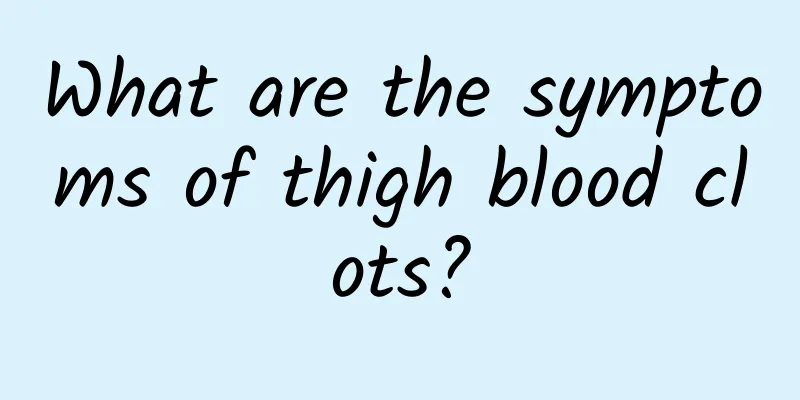What are the symptoms of thigh blood clots?

|
Thigh thrombosis is also quite common in normal times. This is also lower limb venous thrombosis, which can be said to make patients suffer. It often causes swelling of the patient's limbs, causing severe pain, tenderness, varicose veins, etc., and will cause local skin color to darken and change skin color. In severe cases, it can also cause patients to suffer from more critical conditions such as pulmonary embolism. 1. Swelling of the affected limb This is the most common symptom after lower limb venous thrombosis. The tissue tension of the affected limb is high and there is non-pitting edema. The skin color is reddish and the skin temperature is higher than that of the healthy side. When swelling is severe, blisters may appear on the skin. The location of swelling varies depending on the location of the thrombus. Patients with iliac-femoral vein thrombosis have obvious swelling of the entire affected limb; patients with calf venous plexus thrombosis have swelling only in the calf; patients with inferior vena cava thrombosis have swelling in both lower limbs. If the thrombosis starts in the iliac-femoral vein, thigh swelling will appear early. If it starts from the calf venous plexus and gradually extends to the iliac-femoral vein, the calf will swell first and then the thigh will be affected. The swelling is usually heaviest on the 2nd or 3rd day after onset and then gradually subsides. When the disease subsides, it first manifests as a decrease in tissue tension, and then a gradual reduction in the circumference of the affected limb, but it is difficult to return to normal unless the thrombus is completely removed early. In the later stage of thrombosis, although some veins have been reopened, the venous pressure in the affected limb is still high because the venous valve function has been destroyed, and its manifestations are similar to primary lower limb valvular insufficiency. 2. Pain and tendernessThere are two main causes of pain: ① Blood clots cause inflammatory reactions in the veins, causing persistent pain in the affected limb. ② The blood clot blocks the veins, obstructing the venous return of the lower limbs, causing swelling and pain in the affected limbs, and the pain worsens when standing upright. Tenderness is mainly confined to the site of inflammatory response to venous thrombosis, such as the femoral vein or calf. Calf gastrocnemius tenderness is also called a positive Homans sign. Since squeezing the calf may cause the blood clot to dislodge, excessive force should be used during the examination. 3. Superficial varicose veins Superficial varicose veins are a compensatory reaction. When the main vein is blocked, the venous blood in the lower limbs returns through the superficial veins, causing the superficial veins to dilate compensatorily. Therefore, superficial varicose veins are generally not obvious in the acute phase and are a manifestation of the sequelae of lower limb venous thrombosis. 4. Swelling of the thighWhen DVT of the lower limbs extensively involves the intramuscular venous plexus, the iliac femoral veins and their side branches are completely blocked by blood clots, and tissue tension increases extremely, causing lower limb artery spasm, limb ischemia, and even necrosis. Clinically, it manifests as severe pain, shiny skin of the affected limb, accompanied by blisters or blood blisters, and the skin color is bluish-purple, which is called painful cerulea dorsi (Phlegmasia Cerulea Dolens). It is often accompanied by arterial spasm, weakened or absent arterial pulsation in the lower limbs, decreased skin temperature, and then a high degree of circulatory disorder. The patient has a strong systemic reaction, accompanied by high fever, mental weakness, and is prone to shock and wet gangrene of the lower limbs. 5. White swelling of thigh When acute deep vein thrombosis occurs in the lower extremities, lower extremity edema reaches its highest level within a few hours, the swelling is concave and high tension, and the obstruction mainly occurs in the femoral venous system. When combined with infection, the stimulation causes continuous spasm of the arteries, and swelling of the entire limb, pale skin, and dilation of the subcutaneous venous network is seen, which is called painful femoral white seed (Phlegmasia Alba Dolens). |
<<: What foods can dissolve blood clots?
>>: What is the difference between plaque and thrombus?
Recommend
Do you know some common foods that help you sleep and calm your nerves?
Nowadays, many people in life are troubled by the...
What herbs are used to soak your feet to remove moisture?
Many women have a heavy body coldness because the...
The most difficult double eyelid symptoms to repair
Many people hope to have a pair of beautiful big ...
Can I drink saffron while breastfeeding?
Saffron, as the name suggests, is a very common f...
Homemade Sweet and Sour Allium
Many people like to eat sweet and sour radish, an...
What to do when you feel mentally depressed?
Youth needs passion and vitality, but some friend...
How to remove lumps on the face
We all know that people's faces often leave s...
Causes of shortness of breath, check to find the cause in time
If you usually have shortness of breath, you shou...
Can moxibustion cure infertility?
Some women may suffer from infertility due to irr...
Early symptoms of gonorrhea
The so-called gonorrhea, in fact, in daily life, ...
What are the traditional Chinese medicine treatments for aplastic anemia?
Aplastic anemia is a common disease of decreased ...
What to eat to stop bleeding when menstruation is too heavy
If the amount of menstrual blood is heavy during ...
Can Atractylodes macrocephala be used to remove freckles?
Having spots on the face is unacceptable to anyon...
Itchy red bumps around belly button
The belly button is a place that people tend to o...
What should I do if the clitoral hood is too long?
Everyone must have often heard of foreskin being ...









